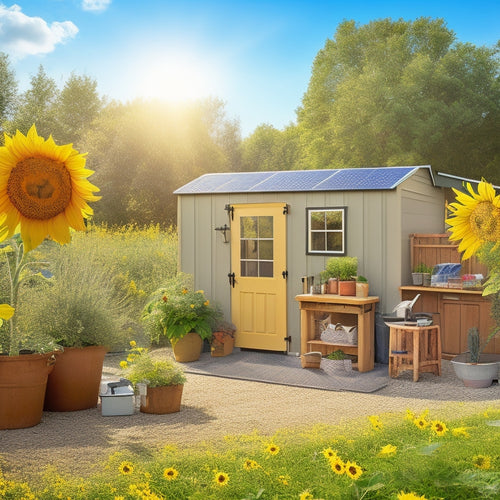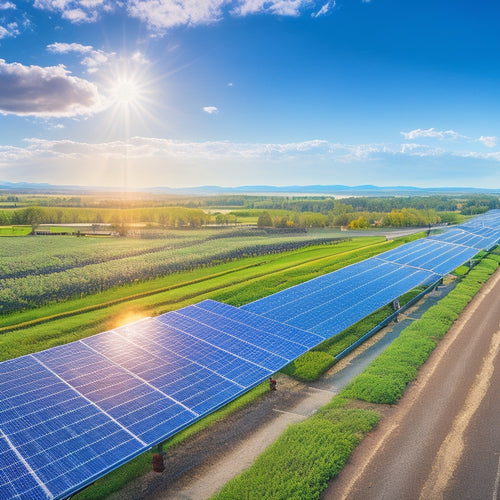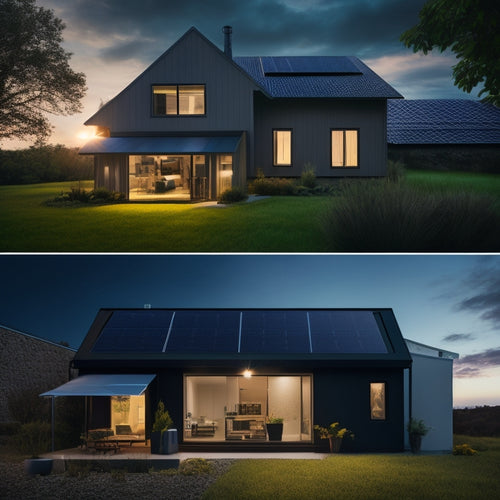
5 Tips for Flat Roof Solar Mounts
Share
When investing in a flat roof solar mount system, you'll want to get it right to maximize energy production. First, assess your roof's solar potential by evaluating its orientation, shading, and features. Then, choose a mounting system that's durable, corrosion-resistant, and compliant with local codes. Consider ballasted or anchored mounts based on your roof type and energy needs. Optimize energy production by adjusting panel angles according to your location, season, and environment. Finally, verify waterproofing and durability by selecting high-quality membranes and scheduling regular inspections. By following these tips, you'll be well on your way to utilizing the full potential of your flat roof solar mount system - and there's more to investigate to further optimize your investment.
Overview
- For flat roofs, choose a mounting system that accommodates the roof's unique characteristics, such as a ballasted mount for added flexibility.
- Ensure the mounting system is durable and corrosion-resistant, using materials like aluminum or stainless steel to withstand harsh weather conditions.
- Consider the weight and size of the solar panels when selecting a mounting system, and ensure it can support the added load.
- Optimize energy production by adjusting the panel angle according to the region's latitude, season, and environmental factors.
- Regularly inspect and maintain the mounting system to ensure waterproofing and durability, scheduling annual technician inspections to prevent damage.
Assessing Your Roof's Solar Potential
Opportunity knocks when your roof is ready to capture the power of the sun. You're taking the first step towards utilizing renewable energy and breaking free from the grid.
To assess your roof's solar potential, you'll need to evaluate its orientation. A south-facing roof is ideal, but don't worry if it's not perfect - you can still generate significant power.
Next, conduct a shading analysis to identify any obstacles that might reduce energy production. Consider nearby buildings, trees, and even your own roof's features like vents or skylights.
Remember to review building codes and verify your roof can support the weight of solar panels and mounting system.
Choosing the Right Mounting System
Get set to secure your solar panels with a mounting system that's customized to your flat roof's unique needs.
When choosing the right mounting system, consider the type of mounting materials that will work best for your roof. Aluminum and stainless steel are popular options due to their durability and resistance to corrosion.
You'll also want to think about the installation techniques that will guarantee a secure and efficient setup. It's crucial to guarantee compliance with local codes and consider factors like wind loads, roof pitch, and panel layout to determine the most suitable approach.
Additionally, adjustable tilt and pitch racks can be beneficial in maximizing energy output, allowing for fine-tuning of solar panel angles seasonally.
Ballasted Vs. Anchored Mounts Compared
Secure your solar panels with confidence by understanding the key differences between ballasted and anchored mounts.
When it comes to cost comparison, ballasted mounts are generally more expensive upfront due to the weight of the ballast materials. However, they eliminate the need for roof penetrations, reducing the risk of leaks and potential future repairs.
It's crucial to evaluate the roof type and its impact on the mounting system, as flat or low-slope roofs may require more flexible design solutions.
Anchored mounts, on the other hand, are more cost-effective initially, but may require additional maintenance and repairs down the line.
Installation challenges also vary between the two. Ballasted mounts often require more labor and equipment to move the heavy ballast, while anchored mounts demand more precision and attention to detail during installation.
Optimizing Energy Production Angles
Three key factors influence the ideal energy production angle of your solar panels: latitude, season, and local environmental conditions.
You'll want to take into account these factors when determining the best solar panel orientation for your flat roof installation. In general, a tilt angle between 25-35 degrees is recommended for most locations.
However, you may need to adjust this angle based on your specific circumstances. For example, if you live in an area with heavy snowfall, a steeper angle may be necessary to guarantee snow slides off easily.
Ensuring Waterproofing and Durability
As you've optimized your solar panel orientation for maximum energy production, you're now ready to focus on ensuring the long-term performance and reliability of your flat roof solar installation. A critical aspect of this is waterproofing and durability. To achieve this, you'll need to select high-quality waterproof membranes and follow best-practice maintenance routines.
| Waterproofing Component | Maintenance Practice |
|---|---|
| Membrane material | Regularly inspect for signs of wear and damage |
| Sealant quality | Perform routine cleaning to prevent debris buildup |
| Flashing design | Schedule annual inspections with a certified technician |
| Drainage system | Keep a record of maintenance activities and repairs |
Frequently Asked Questions
Can I Install Solar Mounts on a Roof With Existing Skylights?
When you're planning your solar installation, you'll need to take into account skylight placement to guarantee ideal solar panel orientation; you can install solar mounts around existing skylights, but it's essential to evaluate the impact on energy output and adjust your layout accordingly.
How Do I Handle Roof Obstructions Like Vents or Pipes?
When handling roof obstructions like vents or pipes, you'll need to implement obstruction solutions, such as custom flashing or raised mounting techniques, to guarantee a secure and efficient solar panel installation that doesn't compromise your energy independence.
Are Solar Mounts Compatible With Different Roofing Materials?
You'll find that most solar mounts adapt to various roofing materials, such as EPDM, PVC, or asphalt, using specialized mounting techniques that guarantee material compatibility, giving you the freedom to choose the best fit for your solar installation.
Can I Walk on the Roof With Solar Mounts Installed?
Oh, you think you're a roofer extraordinaire? Newsflash: solar mounts aren't a jungle gym! You shouldn't walk on the roof with solar mounts installed, period. Prioritize roof safety and respect your solar installation - it's not a playground, folks!
Do Solar Mounts Affect My Roof's Warranty or Insurance?
You'll want to check your roof's warranty and insurance policy to see if solar mounts void or affect them. Typically, warranty implications are minimal, but insurance coverage might require additional riders or premiums, so it's essential you review and understand the terms before installation.
Ready to Buy
You've made it to the final step of installing flat roof solar mounts. Now, it's time to reap the benefits. Did you know that a single watt of solar power can save 300 gallons of water and 2,000 pounds of CO2 over its lifetime? By following these 5 tips, you'll be maximizing your energy production while ensuring a safe and durable installation. With the right mounting system and angle, you'll be generating clean energy in no time. Get ready to utilize the power of the sun!
Related Posts
-

Building an Emergency Backup Solar Power System in 5 Essential Steps
Building an emergency backup solar power system involves five key steps. First, assess your daily energy needs to ide...
-

Applications of Photovoltaic Systems
Photovoltaic systems are versatile, converting sunlight into electricity for various applications. You can use them i...
-

Cost of Home Solar Battery
You're looking to invest in a home solar battery to reduce your grid reliance, but you're curious about the cost. The...


